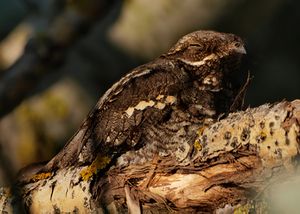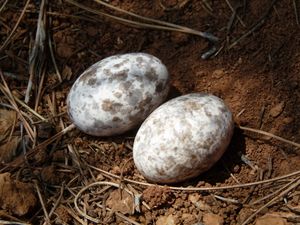سبد أوروبي
| European nightjar | |
|---|---|
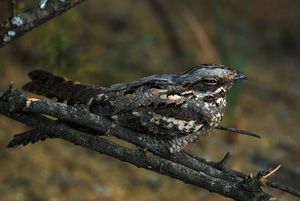
| |
| Calls of a male bird, Surrey, England | |
| التصنيف العلمي | |
| أصنوفة غير معروفة (أصلحها): | Caprimulgus |
| Species: | Template:Taxonomy/CaprimulgusC. europaeus
|
| Binomial name | |
| Template:Taxonomy/CaprimulgusCaprimulgus europaeus | |

| |
| نطاق C. europaeus Breeding Passage Non-breeding | |
سبد أوروبي (الاسم العلمي: Caprimulgus europaeus) إنگليزية: European Nightjar هو طائر ينتمي إلى (فصيلة: Caprimulgidae). nightjar, is a crepuscular and nocturnal bird in the nightjar family that breeds across most of Europe and temperate Asia. The Latin generic name refers to the old myth that the nocturnal nightjar suckled goats, causing them to cease to give milk. The six subspecies differ clinally, the birds becoming smaller and paler towards the east of the range. All populations are migratory, wintering in sub-Saharan Africa. Their densely patterned grey and brown plumage makes individuals difficult to see in the daytime when they rest on the ground or perch motionless along a branch, although the male shows white patches in the wings and tail as he flies at night.
The preferred habitat is dry, open country with some trees and small bushes, such as heaths, forest clearings or newly planted woodland. The male European nightjar occupies a territory in spring and advertises his presence with a distinctive sustained churring trill from a perch. He patrols his territory with wings held in a V and tail fanned, chasing intruders while wing-clapping and calling. Wing clapping also occurs when the male chases the female in a spiralling display flight. The European nightjar does not build a nest, and its two grey and brown blotched eggs are laid directly on the ground; they hatch after about 17–21 days and the downy chicks fledge in another 16–17 days.
The European nightjar feeds on a wide variety of flying insects, which it seizes in flight, often fly-catching from a perch. It hunts by sight, silhouetting its prey against the night sky. Its eyes are relatively large, each with a reflective layer, which improves night vision. It appears not to rely on its hearing to find insects and does not echolocate. Drinking and bathing take place during flight. Although it suffers a degree of predation and parasitism, the main threats to the species are habitat loss, disturbance and a reduction of its insect prey through pesticide use. Despite population decreases, its large numbers and huge breeding range mean that it is classified by the International Union for Conservation of Nature as being of Least Concern.
التبويب
The nightjars, Caprimulgidae, are a large family of mostly nocturnal insect-eating birds. The largest and most widespread genus is Caprimulgus, characterised by stiff bristles around the mouth, long pointed wings, a comb-like middle claw and patterned plumage. The males, and sometimes females, often have white markings in the wing or tail. Within the genus, the European nightjar forms a superspecies with the rufous-cheeked nightjar and the sombre nightjar, African species with similar songs.[2][3] It is replaced further east in Asia by the jungle nightjar which occupies similar habitat.[4]
الأصناف الفرعية
| Subspecies | |||
|---|---|---|---|
| Subspecies | Authority[4] | Breeding range[4] | Comments[3] |
| C. e. europaeus | Linnaeus, 1758 | Across north and central Europe and north Central Asia | The nominate subspecies |
| C. e. meridionalis | Hartert, 1896 | Northwest Africa and southern Europe east to the Caspian Sea | Smaller, paler and greyer than nominate, with larger white spots |
| C. e. sarudnyi | Hartert, 1912 | Kazakhstan to Kyrgyzstan | Variable due to interbreeding with other forms, but generally pale with large white spots |
| C. e. unwini | Hume, 1871 | Iraq and Iran east to Uzbekistan | Hume's nightjar; paler, greyer and plainer than the nominate form and often has white throat patches |
| C. e. plumipes | Przewalski, 1876 | Northwestern China and western Mongolia | A pale, sandy-buff form with large white spots |
| C. e. dementievi | Stegmann, 1949 | Northeastern Mongolia | A poorly known paler and greyer form |
الوصف
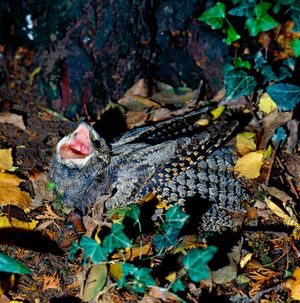
The European nightjar is 24.5–28 cm (9.6–11.0 in) long, with a 52–59 cm (20–23 in) wingspan. The male weighs 51–101 g (1.8–3.6 oz) and the female 67–95 g (2.4–3.4 oz).[4][6] The adult of the nominate subspecies has greyish-brown upperparts with dark streaking, a pale buff hindneck collar and a white moustachial line. The closed wing is grey with buff spotting, and the underparts are greyish-brown, with brown barring and buff spots. The bill is blackish, the iris is dark brown and the legs and feet are brown.[4]
التوزع والموئل
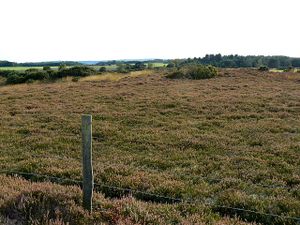
The breeding range of the European nightjar comprises Europe north to around latitude 64°N and Asia north to about 60°N and east to Lake Baikal and eastern Mongolia. The southern limits are northwestern Africa, Iraq, Iran and the northwestern Himalayas.[3] This nightjar formerly bred in Syria and Lebanon.[7]
السلوك
The European nightjar is crepuscular and nocturnal. During the day it rests on the ground, often in a partly shaded location, or perches motionless lengthwise along an open branch or a similar low perch. The cryptic plumage makes it difficult to see in the daytime, and birds on the ground, if they are not already in shade, will turn occasionally to face the sun thereby minimising their shadow.[3][8] If it feels threatened, the nightjar flattens itself to the ground with eyes almost closed, flying only when the intruder is 2–5 m (7–16 ft) away. It may call or wing clap as it goes, and land as far as 40 m (130 ft) from where it was flushed. In the wintering area it often roosts on the ground but also uses tree branches up to 20 m (66 ft) high. Roost sites at both the breeding and wintering grounds are used regularly if they are undisturbed, sometimes for weeks at a time.[9]
التكاثر
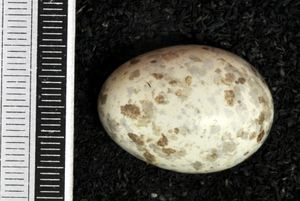
Breeding is normally from late May to August, but may be significantly earlier in northwest Africa or western Pakistan. Returning males arrive about two weeks before the females and establish territories which they patrol with wings held in a V-shape and tail fanned, chasing intruders while wing-clapping and calling. Fights may take place in flight or on the ground. The male's display flight involves a similar wing and tail position with frequent wing clapping as he follows the female in a rising spiral. If she lands, he continues to display with bobbing and fluttering until the female spreads her wings and tail for copulation. Mating occasionally takes place on a raised perch instead of the ground. In good habitat, there may be 20 pairs per square kilometre (50 per square mile).[3]
The European nightjar is normally monogamous. There is no nest, and the eggs are laid on the ground among plants or tree roots, or beneath a bush or tree. The site may be bare ground, leaf litter or pine needles, and is used for a number of years. The clutch is usually one or two whitish eggs, rarely unmarked, but normally blotched with browns and greys.[4] The eggs average 32 mm × 22 mm (1.26 in × 0.87 in) and weigh 8.4 g (0.30 oz), of which 6% is shell.[10]
الغذاء
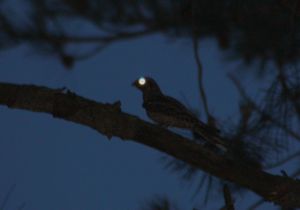
The European nightjar feeds on a wide variety of flying insects, including moths, beetles, mantises, dragonflies, cockroaches and flies. It will pick glowworms off vegetation. It consumes grit to aid with digesting its prey, but any plant material and non-flying invertebrates consumed are taken inadvertently while hunting other food items. Young chicks have been known to eat their own faeces.[3]
في الثقافة
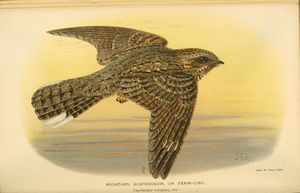
Poets sometimes use the nightjar as an indicator of warm summer nights, as in George Meredith's "Love in the Valley" Lone on the fir-branch, his rattle-notes unvaried/Brooding o'er the gloom, spins the brown eve-jar, Dylan Thomas's
انظر أيضا
ملاحظات
مراجع
- ^ "Caprimulgus europaeus". IUCN Red List of Threatened Species. Version 2013.2. International Union for Conservation of Nature. 2012. Retrieved 26 November 2013.
{{cite web}}: Invalid|ref=harv(help) - ^ del Hoyo, Josep; Elliott, Andrew; Sargatal, Jordi; Christie, David A (eds.). "Caprimulgidae". Handbook of the Birds of the World Alive. Lynx Edicions. Retrieved 11 July 2015.
{{cite web}}: Unknown parameter|subscription=ignored (|url-access=suggested) (help) - ^ أ ب ت ث ج ح خطأ استشهاد: وسم
<ref>غير صحيح؛ لا نص تم توفيره للمراجع المسماةCleere - ^ أ ب ت ث ج ح del Hoyo, Josep; Elliott, Andrew; Sargatal, Jordi; Christie, David A (eds.). "European Nightjar". Handbook of the Birds of the World Alive. Lynx Edicions. Retrieved 10 September 2013.
{{cite web}}: Unknown parameter|subscription=ignored (|url-access=suggested) (help) - ^ خطأ استشهاد: وسم
<ref>غير صحيح؛ لا نص تم توفيره للمراجع المسماةvanGrouw - ^ Mullarney et al. (1999) p. 234.
- ^ Snow & Perrins (1998) pp. 929–932.
- ^ Barthel & Dougalis (2008) p. 108.
- ^ خطأ استشهاد: وسم
<ref>غير صحيح؛ لا نص تم توفيره للمراجع المسماةHolyoak496 - ^ "Nightjar Caprimulgus europaeus [Linnaeus, 1758]". Bird Facts. British Trust for Ornithology. Retrieved 23 February 2014.
Cited texts
- Barthel, Peter H; Dougalis, Paschalis (2008). New Holland Field Guide to the Birds of Britain and Europe. London: New Holland. ISBN 978-1-84773-110-4.
- Blaine, Delabere Pritchett (1816). The outlines of the veterinary art as applied to the horse (2nd ed.). London: T. Boosey.
- Burton, Robert (1985). Bird Behaviour. London: Granada Publishing. ISBN 0-246-12440-7.
- Cleere, Nigel; Nurney, David (1998). Nightjars: A Guide to the Nightjars, Frogmouths, Potoos, Oilbird and Owlet-nightjars of the World. Pica / Christopher Helm. ISBN 1-873403-48-8.
- Cocker, Mark; Mabey, Richard (2005). Birds Britannica. London: Chatto & Windus. ISBN 978-0-7011-6907-7.
- Cocker, Mark; Tipling, David (2013). Birds and People. London: Jonathan Cape. ISBN 978-0-224-08174-0.
- van Grouw, Katrina (2012). The Unfeathered Bird. Princeton: Princeton University Press. ISBN 978-0-691-15134-2.
- Holyoak, David; Woodcock, Martin (2001). Nightjars and Their Allies: The Caprimulgiformes. Oxford: Oxford University Press. ISBN 978-0-19-854987-1.
- Jobling, James A (2010). The Helm Dictionary of Scientific Bird Names. London: Christopher Helm. ISBN 978-1-4081-2501-4.
- Linnaeus, Carl (1758). Systema naturae per regna tria naturae, secundum classes, ordines, genera, species, cum characteribus, differentiis, synonymis, locis. Tomus I. Editio decima, reformata (in Latin). Holmiae: Laurentii Salvii.
{{cite book}}: CS1 maint: unrecognized language (link) - Lockwood, William Burley (1984). Oxford Book of British Bird Names. Oxford: Oxford University Press. ISBN 0-19-214155-4.
- Mullarney, Killian; Svensson, Lars; Zetterstrom, Dan; Grant, Peter (1999). Collins Bird Guide. London: Collins. ISBN 0-00-219728-6.
- O'Connor, Anne (2005). The Blessed and the Damned: Sinful Women and Unbaptised Children in Irish Folklore. Oxford: Peter Lang. ISBN 978-3-03910-541-0.
- Roots, Clive (2006). Nocturnal Animals. Santa Barbara, California: Greenwood Press. ISBN 978-0-313-33546-4.
- Rothschild, Miriam; Clay, Theresa (1957). Fleas, Flukes and Cuckoos. A study of bird parasites. New York: Macmillan.
- Sinclair, Sandra (1985). How Animals See: Other Visions of Our World. Beckenham, Kent: Croom Helm. ISBN 0-7099-3336-3.
- Snow, David; Perrins, Christopher M, eds. (1998). The Birds of the Western Palearctic concise edition (2 volumes). Oxford: Oxford University Press. ISBN 978-0-19-854099-1.
- Valkiunas, Gediminas (2004). Avian Malaria Parasites and other Haemosporidia. London: CRC Press. ISBN 0-415-30097-5.
External links
- Ageing and sexing by Javier Blasco-Zumeta and Gerd-Michael Heinze
- Song at xeno-canto
- Stills images and videos at ARKive
- European nightjar - Species text in The Atlas of Southern African Birds.

